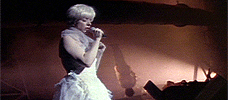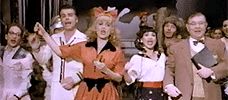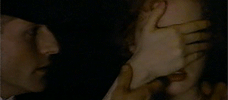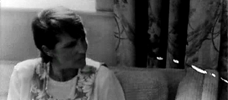Reviews
David Lynch, Lesli Linka Glatter, Jack Fisk, Jonathan Sanger, Betty Thomas
USA, 1992
Credits
Review by Evan Kindley
Posted on 13 July 2010
Source DivX video
Categories David Lynch’s 1990s
The brief success that Twin Peaks enjoyed on ABC had some strange side effects. One was the immediate roll out of the usual variety of knock-offs (Picket Fences, Northern Exposure, Wild Palms, Eerie, Indiana)—some good, some bad, but none really approaching the uniqueness and sophistication of their model. Another was the fact that, for a very brief time in the history of network television, Lynch and Frost had carte blanche. Rather than follow up their success with a variation on Twin Peaks, Lynch and Frost went in another stylistic direction entirely, creating a half-hour situation comedy set at a 1950s television studio that owes more to broad mid-century slapstick - Sturges, Tashlin, Jerry Lewis, the Three Stooges, Jacques Tati, even Mel Brooks - than it does to the noir, soap opera, and murder mystery traditions that inform the earlier series. Where Twin Peaks was sexy, spare, and slow-paced, On the Air was goofy, dense, and almost unbearably frantic. An elegant opening credits sequence set to Angelo Badalamenti’s languid, jazzy theme is punctuated by unnerving silence and a couple of squelchy analog farts, as good a way as any to set the tone for a show that combines classicist nostalgia with lowbrow surrealist mayhem.
The basic building blocks of On the Air are all present in the pilot episode, written by Lynch and Frost and directed by Lynch.1 The show takes place almost entirely inside the Zublotnick Broadcasting Company television studio in New York, where a sketch and variety program called The Lester Guy Show is recorded live. Despite disaster befalling the actors during literally every broadcast, the show is a surprise hit, mostly on the strength of Lester’s likable, plucky, and idiotic co-star Betty Hudson. (As network liaison Buddy Budwaller aptly remarks of her, “She’s no dim bulb, she’s a blown-out fuse.”) In each episode, Lester plots against Betty in order to prevent her stealing focus from him; in each she triumphs, obliviously, somehow becoming a bigger and bigger star.
But the fairly conventional plots are pretty much just armatures for some of the strangest incidents to occur on prime time network television since the cancellation of Mary Hartman, Mary Hartman. There are frequent cuts away from the action to shots of the audience watching at home (a little old lady with her dogs, a cowboy with his horse, two dogs in bizarre costumes, a nurse with her patients in the ER, a convict in prison); network executives sitting in a roped-off area that is frequently overrun by ducks; and, most daringly, digitally manipulated images from the point of view of sound effects technician Blinky Watts, who, we are repeatedly told in voiceover, “is not blind,” but rather “suffers from Boseman’s Simplex,” meaning he sees what we do, only multiplied and blanketed by a blizzard of strange objects like stuffed animals, Santa Claus figurines, and gardening implements. Other recurring jokes repeat themselves with the reliability of sacred rituals: appearances by conjoined in-house efficiency experts the Hurry-Up Twins; Vadja Gochktch, the show’s director, shouting into the wrong end of a megaphone; an elderly announcer who has a girl sitting next to him to moisten him with a spray bottle right before he speaks; and a direct phone line to Mr. Zubotnick that spews fire and, sometimes, water.
Lynch’s knack for comedy is underrated and frequently misunderstood, even by his admirers, but it has to be said that the verbal humor in the early episodes of On the Air is beyond crude, on the order of the following shouted exchange: “Nein! Nein!” “How many? How many?” Only in the final episodes is some of the subtlety and sophistication of Twin Peaks’ dialogue beginning to show (Budwaller: “You know, there’s a legend about a tribe of Indians in the Andes whose threshold of pain was so high that one of their favorite pastimes was throwing rocks at each other’s heads. I understand that feeling at this moment”). But if the scripts are uneven, the cast helps to make up the difference. Lester Guy is played by the foppish Ian Buchanan, better known as “Dick Tremayne” to Twin Peaks viewers, who will also recognize Miguel Ferrer (FBI Agent Albert Rosenfield) in familiar barking, no-bullshit mode as Buddy Budwaller. Other faces are new but still somehow familiar: Marla Rubinoff, who plays Betty, is a dead ringer for Twin Peaks’ Kimmy Robertson, but with an even squeakier Judy Holliday voice; and Ruth Trueworthy, Mr. Gochktch’s helpful assistant (played by Nancye Ferguson) who has a good-girl look not dissimilar to Donna Hayward. Then there’s Mr. Gochktch himself, a foreigner of indeterminate origin (his accent sounds alternately German, Swedish, Polish, and Scottish), and Mr. McGonigle, a befuddled Jewish producer with a nervous condition and an occasional milk-of-magnesia mustache. (In their predilection for broad ethnic stereotypes, Lynch and Frost sometimes approach Coen Brothers territory).
Unsurprisingly, ABC gave the show a stunning vote of no confidence, placing it in a 9:30 time slot on Saturdays in the summer, and ultimately airing only three of the seven episodes produced. It would take a very hardened avant-gardist to blame them: in no conceivable universe would On the Air have been a hit, even on the modest level Twin Peaks had established. Its tendencies toward absurdist provocation were, if anything, getting more pronounced: the last few episodes end in utter chaos, only sketchily motivated by what came before. After a series of catastrophic mechanical failures, Episode 5 concludes with the entire cast and crew singing a song to convince a ventriloquist’s dummy not to commit suicide; the end of Episode 6 finds Lester shrunk down to the size of a mouse and then teleported to Akron, Ohio; and the final episode, written by Lynch and Robert Engels, finishes the whole show in grand style with an extended beatnik dance sequence set to backwards percussion that anticipates the stunning use of Nina Simone’s “Sinnerman” in the last scene of Inland Empire, fourteen years later. (Oh yeah, and there’s also a dog playing bongos.)
Self-indulgent though it may be, it’s a pity that On the Air wasn’t allowed to develop past the seventh episode; it was definitely zeroing in on its own peculiar niche, and in time might have gotten out of Peaks’ shadow. And from the beginning, it had a great look: despite a revolving cast of directors (including Lesli Linka Glatter, who got her start on Twin Peaks and would go on to win awards for Mad Men), the show maintained both a convincing period feel and that ineffable Lynchian quality at all times. With its very precise art direction, elegant cinematography (by Peter Deming, who would later shoot Lynch’s Lost Highway and Mulholland Dr.), careful attention to background detail, and innovative sound editing2 it was well ahead of its time for a half-hour comedy. While it remains an anomaly in Lynch’s canon and can’t entirely be called a success, On the Air is impressive - and, on occasion, funny - enough to make one wish Lynch would try his hand at comedy again.
It also resonates, once you get past the surface silliness, with the rest of his oeuvre, and not just in its arbitrary details (like the contrast between blonde Betty and brunette Ruth that Lynch would revive for Mulholland Dr., for instance). From Eraserhead to Inland Empire, the idea of complete immersion in an art work - of actually living inside a self-contained world of one’s own creation - has been a source of fascination for Lynch, and On the Air, in its humble way, is another exploration of that concept. With the exception of an excursion to an Italian restaurant in the second episode, none of the characters are ever seen outside the studio, and you get no sense that they have any desires or interests beyond The Lester Guy Show. The studio is a womb. There is nothing else, nor should there be. And yet, against this hermeticism, there is also the palpable excitement that Lynch and Frost seem to feel about commandeering a populist medium, one that potentially allows them access to the everyday lives of ordinary people (and animals). “Think of it… there’s ten million Americans out there, waiting to see our premiere, knock wood!” McGonigle exclaims in the opening moments of the show’s pilot. It’s unlikely that a fraction of that number have seen On the Air since it was made, but the very idea of its finding its way into the homes and brains of America animates and energizes the whole affair, and makes it worth the trouble of seeking out today.
- While Twin Peaks is more frequently cited as Lynch’s definitive television statement, he was actually more involved in the day-to-day production of On the Air than he was with Twin Peaks, whose first season was filmed at the same time as Wild at Heart: “I’m talking about little details, little abstractions. God is in the details.” “Television of the Absurd: ‘Twin Peaks’ Co-Creators Try Again With ‘On the Air,’” Los Angeles Times, June 18, 1992. ↩
- Lynch reportedly conceived the idea for On the Air when he was mixing the sound for Twin Peaks’ second season, and the show occasionally feels like an elaborate excuse for him and Badalamenti to indulge some of their goofier audio instincts: boinging springs, flatulent tuba blasts, tire screeches, conga drums, pipe organs, jazz flute, mechanical clanking, assorted synthesized bleeps and blurps, and the good old Record Needle Scratch are among the funny noises to be heard on a typical episode of On the Air.↩
More David Lynch’s 1990s
-

Industrial Symphony No. 1
1990 -

On the Air
1992 -

Hotel Room
1993 -

Premonitions Following an Evil Deed
1995 -

Lost Highway
1997
We don’t do comments anymore, but you may contact us here or find us on Twitter or Facebook.



